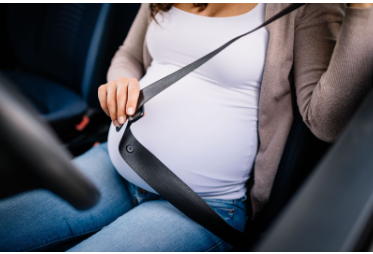Only 32% of pregnant Colorado drivers wear their seat belt correctly
News Release
Statewide — Recent data highlights a concerning gap in road safety practices, specifically among a vulnerable group — pregnant people. The numbers tell a sobering tale. Too many are incorrectly using a crucial safety measure that could protect both themselves and their unborn children during motor vehicle collisions: seat belts.

Car Seats Colorado, a partnership of CDOT and Colorado State Patrol, would like to remind drivers and passengers that keeping kids safe while traveling in a vehicle starts even before the baby arrives.
Analysis of 1,712 prenatal seat belt checks by the UCHealth EMS/Hudson Center for Prenatal Vehicle Safety found only 32% of pregnant vehicle occupants were using seat belts correctly.
“Seat belts are our first line of defense in a vehicle in the event of a crash,” said Darrell Lingk, director of the Highway Safety Office at CDOT. “However, their effectiveness hinges on being worn correctly, which can be complex given the unique physical changes that occur during pregnancy.”
Motor vehicle collisions are a leading cause of fetal injury and death in the U.S., according to the National Highway Traffic Safety Administration (NHTSA). But proper seat belt use reduces adverse fetal outcomes by 84%, according to academic peer-reviewed research.
“Maternal and fetal mortality are only part of the picture,” said Community Outreach Captain for UCHealth Emergency Medical Services Gregory Colton, who champions the issue. “For prenatal patients, motor vehicle crashes lead to higher rates of premature rupture of membranes, placental abruption, premature birth, and low birth weight.”
According to UCHealth, many pregnant people unknowingly use their seat belt incorrectly. These include the lap belt riding up over the belly, a gap between the clavicle and shoulder belt, and having their belly/chest too close to the steering wheel.
If all pregnant vehicle occupants wore their seat belt correctly, motor vehicle crash-related fetal loss could decline by more than 50%.
“Expectant parents hold a unique responsibility to protect not just themselves but also their unborn children,” said Trooper Kent Trimbach, Car Seats Colorado child passenger safety coordinator. “Many pregnant people may not realize that the way they wear their seat belt could impact their baby’s safety so dramatically. By raising awareness and providing clear guidance, our goal is to empower parents-to-be to ensure their safety and the safety of their vulnerable cargo.”
The following is the method of seat belt fit and vehicle seat positioning for pregnant vehicle occupants recommended by NHTSA and the American College of Obstetricians and Gynecologists:
Seat Belt Fit
- Lap belt placed low under the curve of the belly and resting on the hips.
- Shoulder belt to the side of the belly and diagonally across the center of the chest.
- Shoulder belt crossing the middle of the clavicle, resting on the shoulder.
Vehicle Seat Adjustment
- Seat back upright, or as upright as the pregnant person can tolerate.
- Seat adjusted back so the belly does not press against the steering wheel and there is at least 10 inches of space between the center of the steering wheel and the chest.
- Seat also close enough so the pregnant driver can press the brake pedal to the floor.
Steering Wheel
- Tilted so the airbag is directed towards the chest, not the belly or face.
- Steering column distance adjusted so driver can comfortably reach the top of the steering wheel while providing space for airbag deployment.
If you are in a crash when pregnant, seek immediate medical attention and notify your prenatal care provider, even if you do not feel injured.
UCHealth EMS includes seat belt checks for pregnant people at all car seat and CPR-education appointments. The process takes about 5-10 minutes to complete. The public can register for prenatal seat belt checks here.
To learn more about car seat, booster seat and seat belt usage and to find more seat-check resources in Colorado, visit CarSeatsColorado.com.
About Car Seats Colorado
Car Seats Colorado is a joint effort of the Colorado State Patrol, CDOT, local car seat technicians, law enforcement, emergency services and other professionals who are dedicated to implementing child passenger safety programs and encouraging parents to take the necessary steps to protect their children when in vehicles. Learn more about how to keep children safe in vehicles and download informational resources at CarSeatsColorado.com.
